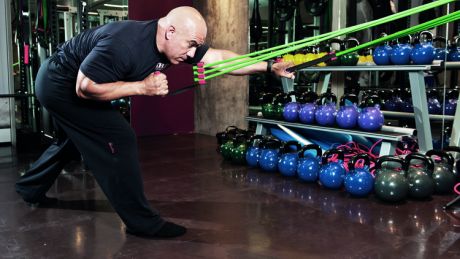The Four Key Principles Of Functional Training
Functional training guru JC Santana checks your form and instructs us on the four key principles of functional training

You’re in the functional area of your gym. You’re standing on a gym ball, attempting to squat with 60kg on your back. You think you’re working on your balance. I think you’re a fool.
Functional training is a very misunderstood concept. It isn’t using gym kit inappropriately in moves such as gym ball squats, or using the iron cross to measure shoulder stability. It is doing exercises that replicate movements you do in your sport or everyday life.
Here’s my full definition of functional training: it’s training that strengthens and conditions the specific mechanical and energetic characteristics of the human body consistent with a target. This is applied to your training through the four pillars – locomotion, level changes, push and pull, and rotation. Here’s how you can build a functional workout from them.
Locomotion
Whatever your activity, it will involve you moving from point A to point B. You might do this by skipping, jumping, sidestepping or simply sprinting. But without a doubt, single-leg movements will dominate. Everyone wants to use squats in their training and you can do them until you’re blue in the face but you’re not going to improve that single-leg step. You want proof? Powerlifters are the heaviest squatters on the planet but they’re among the slowest athletes. So what should you swap for squats? The single-leg anterior reach.
Level changes
This is about moving from low to high. When you get up from a fall, go from low to high when wrestling or even pick up one end of a sofa, you’ll be in a staggered stance, not a parallel one as is common with deadlifts. So to make these exercises more functional you should do staggered deadlifts. Use dumbbells or vary the angle of the lift by using cables.
Push and pull
In life, most pushing and pulling movements occur while you’re standing, and that means you’ll need to engage your core as well as the specific muscles that are doing the pushing or pulling. Functional pushing movements, such as pushing an opponent away from you or a fridge against a wall, require you to exert force while standing. So for functional pushing strength, ditch the bench press and do standing cable presses instead. With pulling motions, you’re typically pulling something towards you, often off the ground, and that’s where bent-over rows come in. Pull-ups are good for training various grips required for sports, but rows are the best functional pulling move.
Rotation
This requires a dual approach. When running or twisting in sports such as tennis or baseball, you require rotation to accelerate and decelerate your movement, but you also need a degree of stiffness to your core to sustain the force. Cycling crunches and similar core moves won’t develop this dual strength. Instead, do twisting exercises using resistance bands or cables. My favourite is the band or cable rotation [described in the box below] which is ideal for creating core strength.
Sign up for workout ideas, training advice, reviews of the latest gear and more.
See related
- What Is Functional Fitness?
- A 30-Minute Functional HIIT Circuit Anyone Can Try
- Build Functional Fitness With This 20-Minute Barbell Workout
How To Use Functional Training To Improve At Sport
Football
“The single-leg anterior reach is the king of running sports exercises,” says Santana. “It’s great for mobility and balance.’ Stand on one leg with the other in the air. Bend forwards at your hips and touch the toes on your standing foot with the opposite hand, keeping your raised leg straight behind you. Repeat on the other side. Do four sets of ten each side.”
Rugby
“For sudden changes in direction and to absorb impact you need to work on your core with cable rotations. Stand perpendicular to a cable set at chest height. Hold it with both hands in front of you. Imagine this is your 12 o’clock. Rotate between ten and two o’clock without your hips rotating. Use slight rotational movements with as much weight as you can handle. Do four sets of ten.”
Cricket
“Band rotations will help you develop the twisting movement you need for batting, but for bowling and fielding you can increase your throwing power with a staggered stance single-arm cable press. Facing away from a cable machine, with one leg forward and one back, perform a single-arm chest press. Aim to do four sets of ten reps on each side.”
Coach is a health and fitness title. This byline is used for posting sponsored content, book extracts and the like. It is also used as a placeholder for articles published a long time ago when the original author is unclear. You can find out more about this publication and find the contact details of the editorial team on the About Us page.

